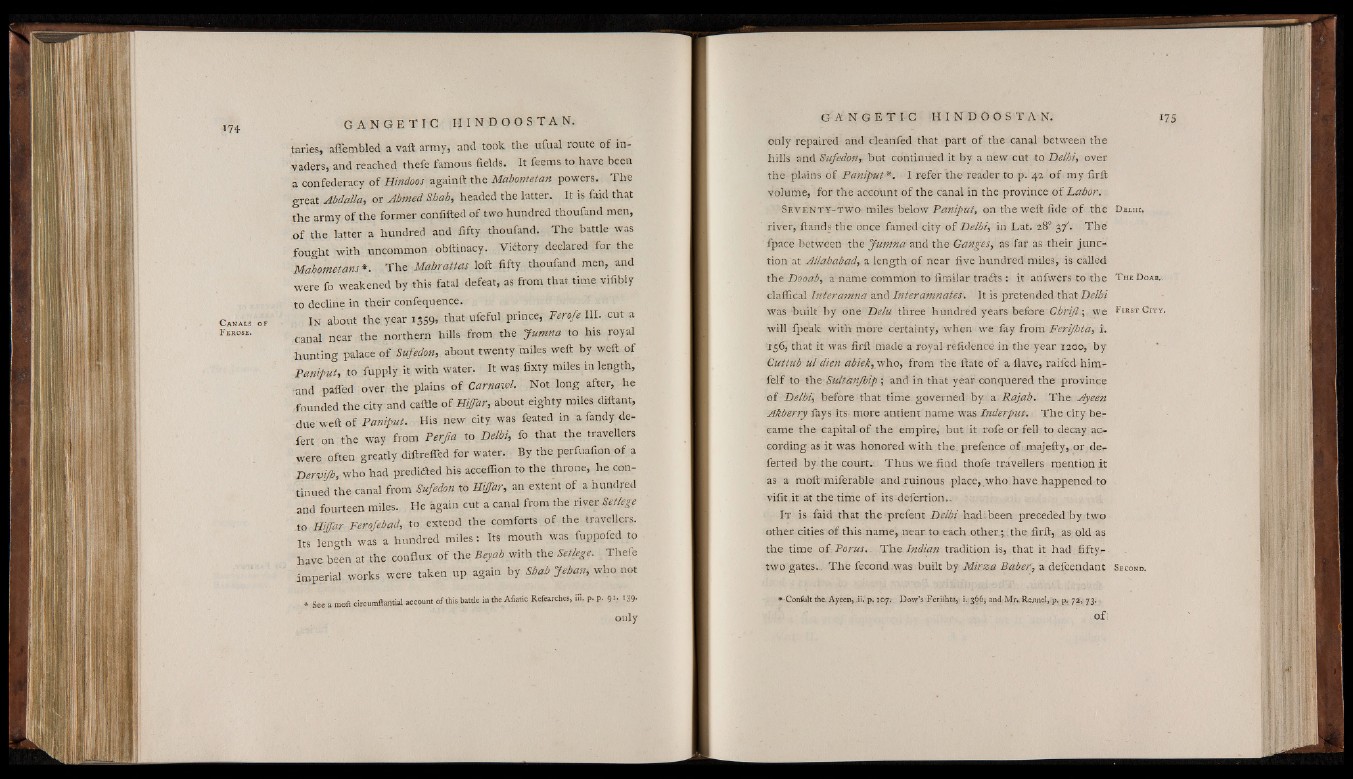
taries, affembled a vaft army, and took the ufual route of invaders,
and reached thefe famous fields. It feems to have been
a confederacy of Hindoos againft the Mahometan powers. The
great Abdalla, or Abmed Sbah, headed the latter. It is faid that
the army of the former confifted of two hundred thoufand men,
of the latter a hundred and fifty thoufand. The battle was
fought with uncommon obllinacy. Victory declared for the
Mahometans*. The Mabrattas loft fifty thoufand men, and
were fo weakened by this fatal defeat, as from that time vifibly
to decline in their confequence.
C a n a l s o f ! In about the year 1359, that ufeful prince, Ferofe III. cut a
Feross- canai „ear the northern hills from the Jumna to his royal
hunting palace of Sufedon, about twenty miles weft by weft of
Paniput, to fupply it with water. It was fixty miles in length,
•and paired over the plains of Carnawl. Not long after, he
•founded the city and caftle of HiJJar, about eighty miles diftant,
due weft of Paniput. His new city was feated in a fandy defect
on the way from Perfta to Delhi, fo that the travellers
were often greatly diftrefled for water. By the perfuafion of a
Dervijh, who had predifted his acceffion to the throne, he continued
the canal from Sufedon to Hijfar, an extent of a hundred
and fourteen miles. He again cut a canal from the river Setiege
to Hifar Ferofebad, to extend the comforts of the travellers.
Its length was a hundred miles: Its mouth was fuppofed to
have been at the conflux of the Beyah with the Setiege. Thefe
imperial works were taken up again by Sbah Jeban, who not
* See a moil circumftantial account of this battle in the Aiiatic Refearches, iil, p. p. 91. 139-
only
only repaired and cleanfed that part o f the canal between the
hills and SufedonT but continued it by a new cut to Delhi, over
the plains of Paniput*. I refer the reader to p. 42 o f my firft
volume, for the account of the canal in the province of Labor.
S e v e n t y - t w o miles below Paniput, on the weft fide o f the D elhi.
river, ftands the-once famed city of Delhi, in Lat. 28° 37'. The
fpace between the Jumna and the Ganges, as far as their junction
at Allahabad, a length of near five hundred miles, is called
the Dooab, a name -common to fimilar traits : it anfwers to the T h eD o a b ..
elaffical Interamna and Inter amnates. It is pretended that Delhi
was built by one Delu three hundred years before Ch'rijl -,, we F i r s t C i t y .
will fpeak with more certainty, when we fay from Ferijhta, i.
156, that it was firft made a royal-refidence in the year 1200, by
Cuttub ul dien abiek, •who, from the ftate of a flave, raifedhim-
felf to tlm SultanJhip ; and in that year conquered the province
of Delhi, before that time, governed by a Rajah. The Ayeen
Akberry fays its: more antient name was Inderput. The city became
the capital of the empire, but it rofe or fell to decay according
as it was honored with the. prefence of, majefty,.or deferred
by. the court.: Thus we. find thofe travellers mention it
as a moft miferable and ruinous place, who have happened to
vifit.it at the time of its defertion..
I t is faid that the prefent Delhi had:been preceded by two
other cities of this name, near. to. each other.; the firft, as old as
the time o f Porus.. The Indian tradition is, that it had fifty--
two gates... The fecond was built by Mirza Baber, a defcendant Second.
• “Confalt the. Ayeen, ,ii. p. 107; Dow’s Feriftita,. 1.366$ and Mr. R.ennel, 'p. p. 72,- 73..
of